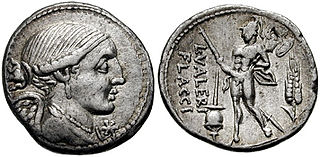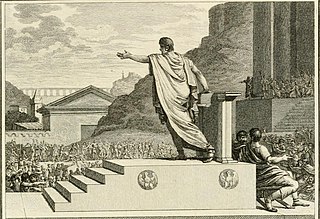Related Research Articles

The gens Valeria was a patrician family at ancient Rome, prominent from the very beginning of the Republic to the latest period of the Empire. Publius Valerius Poplicola was one of the consuls in 509 BC, the year that saw the overthrow of the Tarquins, and the members of his family were among the most celebrated statesmen and generals at the beginning of the Republic. Over the next ten centuries, few gentes produced as many distinguished men, and at every period the name of Valerius was constantly to be found in the lists of annual magistrates, and held in the highest honour. Several of the emperors claimed descent from the Valerii, whose name they bore as part of their official nomenclature.
Quintus Fabius Q. f. M. n. Maximus Gurges, the son of Quintus Fabius Maximus Rullianus, was consul in 292, 276, and 265 BC. After a dissolute youth and a significant military defeat during his first consulate, he was given the opportunity to salvage his reputation through the influence of his father, and became a successful general, eventually holding the highest honours of the Roman state. He was slain in battle during his third and final consulate.

Pandosia was an ancient city in Bruttium, in what is now Calabria, southern Italy. According to Livy it was situated near the border between Bruttium and Lucania. Strabo writes it was located in Bruttium, a "little above" Consentia. The Barrington Atlas of the Greek and Roman World places the site of the city in the vicinity of Cosenza, but the village Acri and Castrolibero has been suggested as a more precise location.

The gens Sempronia was one of the most ancient and noble houses of ancient Rome. Although the oldest branch of this gens was patrician, with Aulus Sempronius Atratinus obtaining the consulship in 497 BC, the thirteenth year of the Republic, but from the time of the Samnite Wars onward, most if not all of the Sempronii appearing in history were plebeians. Although the Sempronii were illustrious under the Republic, few of them attained any importance or notice in imperial times.

Trebula or Trebula Balliensis or Trebula Baliensis, was an ancient city of Campania, Italy, the location of which is occupied by the modern village of Treglia in the comune of Pontelatone. The Monti Trebulani, a small mountain group in the modern province of Caserta, take their name from it.

Eretum, was an ancient town of the Sabines, situated on the Via Salaria, at its junction with the Via Nomentana, a short distance from the Tiber, and about 30 km (19 mi) from Rome.
Quintus Fabius Maximus Gurges was Roman consul in 265 BC, and died of wounds received in battle at Volsinii, where he had been sent to help put down a revolt. There is some uncertainty as to his identity.
Publius Sempronius C.f. Tuditanus was a Roman Republican consul and censor, best known for leading about 600 men to safety at Cannae in August, 216 BC and for the Treaty of Phoenice which ended the First Macedonian War, in 205 BC.
Cynus was the principal sea-port of the Opuntian Locrians, situated on a cape at the northern extremity of the Opuntian Gulf, opposite Aedepsus in Euboea, and at the distance of 60 stadia from Opus. Livy gives an incorrect idea of the position of Cynus, when he describes it as situated on the coast, at the distance of a mile from Opus. Cynus was an ancient town, being mentioned in the Homeric Catalogue of Ships in the Iliad. It was reported to have been the residence of Deucalion and Pyrrha; the tomb of the latter was shown there. Beside Livy and Homer, Cynus is mentioned by other ancient authors, including Strabo, Pomponius Mela, Pliny the Elder, and Ptolemy.
Delium was a small town in ancient Boeotia with a celebrated temple of Apollo. It was located upon the sea-coast in the territory of Tanagra in Boeotia, and at the distance of about a mile (1.6 km) from the territory of Oropus. This temple, which like the town took its name from the island of Delos, is described by Livy as overhanging the sea, and distant 5 miles (8.0 km) from Tanagra, at the spot where the passage to the nearest parts of Euboea is less than 4 miles (6.4 km). Strabo speaks of Delium as a temple of Apollo and a small town (πολίχνιον) of the Tanagraei, distant 40 stadia from Aulis.
Aulus Postumius Albinus was a politician of Ancient Rome, of patrician rank, of the 3rd century BC.

The gens Vibia was a plebeian family at ancient Rome. Although individuals named Vibius appear in history during the time of the Second Punic War, no members of this gens are found at Rome until the final century of the Republic. The first of the Vibii to obtain the consulship was Gaius Vibius Pansa in 43 BC, and from then until imperial times the Vibii regularly filled the highest offices of the Roman state. The emperors Trebonianus Gallus and Volusianus each claimed descent from the family.

The gens Postumia was a noble patrician family at ancient Rome. Throughout the history of the Republic, the Postumii frequently occupied the chief magistracies of the Roman state, beginning with Publius Postumius Tubertus, consul in 505 BC, the fifth year of the Republic. Although like much of the old Roman aristocracy, the Postumii faded for a time into obscurity under the Empire, individuals bearing the name of Postumius again filled a number of important offices from the second century AD to the end of the Western Empire.
The gens Blossia, also spelled Blosia, was a Roman family of Campanian origin, which came to prominence during the Second Punic War. The most famous member of this gens is probably Gaius Blossius, an intimate friend of Tiberius Sempronius Gracchus, whom he urged to bring forward his agrarian law. He fled from Rome after the murder of Gracchus, and eventually took his own life for fear of falling into the hands of his enemies.

The gens Lucretia was a prominent family of the Roman Republic. Originally patrician, the gens later included a number of plebeian families. The Lucretii were one of the most ancient gentes, and the second wife of Numa Pompilius, the second King of Rome, was named Lucretia. The first of the Lucretii to obtain the consulship was Spurius Lucretius Tricipitinus in 509 BC, the first year of the Republic.

Over the course of nearly four centuries, the Roman Republic fought a series of wars against various Celtic tribes, whom they collectively described as Galli, or Gauls. Among the principal Gallic peoples described as antagonists by Greek and Roman writers were the Senones, Insubres, Boii, and Gaesatae.
The gens Laetoria was a plebeian family at ancient Rome. Its members appear regularly throughout the history of the Republic. None of the Laetorii ever obtained the consulship, but several achieved lesser offices of the Roman state.
The gens Laelia was a plebeian family at Rome. The first of the gens to obtain the consulship was Gaius Laelius in 190 BC.
The gens Oppia was an ancient Roman family, known from the first century of the Republic down to imperial times. The gens may originally have been patrician, as they supplied priestesses to the College of Vestals at a very early date, but all of the Oppii known to history were plebeians. None of them obtained the consulship until imperial times.
The Arch of Scipio was an ancient Roman arch located atop the Capitoline Hill.
References
- ↑ Livy. Ab urbe condita Libri [History of Rome]. Vol. 24.
- ↑ Livy, xxv. 14.
- ↑ Valerius Maximus, iii. 2. § 20.
- ↑ Dictionary of Greek and Roman Geography, vol. I, p. 11 ("Accua").
- ↑ I.E.M. Edlund Berry, A.M. Small, R. Talbert, Sean Gillies, Tom Elliott, and Jeffrey Becker, 'Accua: a Pleiades place resource', Pleiades: A Gazetteer of Past Places, 2021 <https://pleiades.stoa.org/places/446208> [accessed: 05 January 2021]
![]() This article incorporates text from a publication now in the public domain : Smith, William, ed. (1854–1857). "A'ccua". Dictionary of Greek and Roman Geography . London: John Murray.
This article incorporates text from a publication now in the public domain : Smith, William, ed. (1854–1857). "A'ccua". Dictionary of Greek and Roman Geography . London: John Murray.